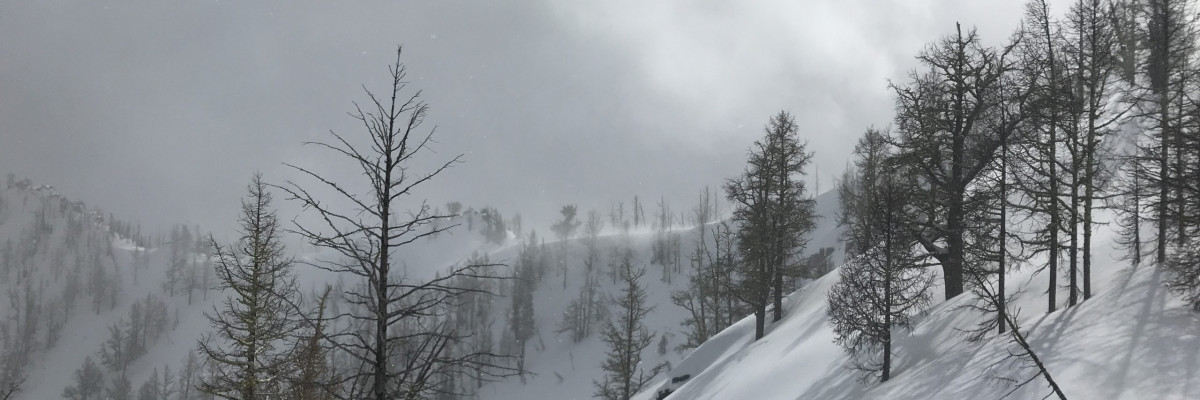The avalanche danger is Considerablein wind loaded terrain and moderate in all other terrain the west central Montana backcountry.
Good morning, this is Jeff Carty with the West Central Montana avalanche advisory for March 5, 2020. Today’s advisory is sponsored by The Trail Head. This advisory does not apply to operating ski areas, expires at midnight tonight, and is the sole responsibility of the U.S. Forest Service.
Weather and Snowpack
Over the past 48 hours westerly winds have blown up to:
- 54mph with gusts to 77 mph at Point 6
- 80 mph at Lolo Pass
There were sustained strong winds for over 24 hours throughout the forecast area. Do to local terrain affects multiple aspects are impacted by these winds. Winds are currently light and forecast to be light with strong gusts throughout the day.
Mountain temperatures have ranged from:
- 15º to 33º above 6000’ and are forecast to rise as high as 49º today.
Snow accumulation in the past 48hr is roughly:
- 10” in the Seeley-Swan
- 5” in the Rattlesnake
- 8″ at Lolo Pass
- 8” new in the central Bitterroot
- 3″ in the southern Bitterroot
Our primary concern is wind slab. These have grown to over three feet thick in some areas, are very sensitive and likely to be triggered by a skier or rider.
Yesterday at Lolo, Travis was getting 10’ long shooting cracks while touring. Snowbowl was closed due to wind, expect extensive wind slab in the Rattlesnake. Wind transport and loading have been extensive and considerable throughout the forecast area (video). Due to the strength of the wind, slabs may be lower on slopes than normally encountered, and deposited on multiple aspects. Steep wind loaded terrain >33º should be approached with caution.
In other areas such as the Gash and the first bowl at Wishard Ridge, wind slabs were not an issue, the snowpack has bonded well despite wind transport. There is a lot of variability throughout the forecast area but the extent of the wind effect means you should approach any avalanche slope with caution and evaluate the touchiness of windslab before preseeding.
Where there is not wind loading the snowpack is, overall, well bonded and stable. There are, however, exceptions.
Buried surface hoar can be found in isolated areas. It is present and reactive on sections of Mt. Fuji (video) and maybe lurking on other sheltered north slopes. Dig a pit, perform tests and look for it before committing to steep terrain.
There are near-surface facets growing underneath the 02/28 crust. While it is not currently an issue, it may become a problem layer with a load of new snow on it.
In the southern Bitterroot, depth hoar at the bottom of the snowpack is still a concern. Choose a shallow spot to dig. If you find weak sugary snow at the bottom of your pit, choose a different slope where this structure is not present.
Warm, above seasonal temperatures today and Friday will increase the risk of wet loose avalanches, especially on sun warmed aspects. The extent of warming will loosen bonds within the snowpack and may make layers that have been unreactive more sensitive, increasing the risk of slab avalanches. The hazard from warming will increase throughout the day with rising temperatures.
Bottom Line
Strong winds have built dangerous wind slabs at a variety of elevations, avoid steep wind loaded terrain. Very isolated pockets of a buried surface hoar and crust/facet layer exist. Perform a stability test to evaluate these layers. Depth hoar in the southern Bitterroot is a low likelihood, high consequence problem and still deserves caution. Wet loose avalanches are an increasing risk throughout the day as temperatures rise. Travel one at a time in avalanche terrain, carry a beacon, shovel, and probe, and stay alert for signs of instability. Look for red flags. Give cornices a wide berth, they will be more likely to fall with the warming.
Education
Your observations are extremely helpful! If you get out, please take a minute to fill out the observation form on our website (missoulaavalanche.org), or shoot us a quick email at [email protected].
We offer a variety of avalanche courses throughout the winter. Go to our course offerings page on our website. Check out the list and get yourself enrolled in one of our many courses this winter!
Ski and ride safe.














